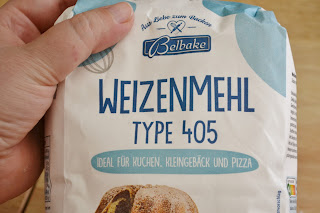Tutorial: German Flour Types
I recently saw a recipe for a kind of German bread and suddenly I wasn't sure what I was looking at as the flour came with a number. I decided I needed to learn what those numbers on the flour description actually means.
I got my information from this website: https://www.cooksinfo.com/german-flours
Any flour made out of wheat will be called "Weizenmehl". However, there are several different kinds. The most common kind of flour is 405. So, let's start with what in the world does that number mean? Evidently, it is the "ash content". Wait, is there ash in my flour? Of course not. But, if this kind of flour were burned to ash, there would be 405mg of ash left over from 100g of flour. This number indicates the amount of minerals in the flour itself. The higher the number, the more minerals and fibers in the flour. 405 is the lowest amount. The closest American equivalent is cake flour. However, cake flour has less protein than German 405 flour, so it's not an exact equivalent, but it is the closest to cake flour that Germany has to offer.
The next one is 550. 550 flour is a bit more robust and works better for bread baking than 405 flour because it has more gluten. It's closest American equivalent is all-purpose flour. And it is quite similar.
Next comes 812. 812 flour is even more robust than 550 and is closest to American bread flour. This one is great for making heavier, German bread recipes. It's sometimes called Bauernbrot-Mehl. It can be hard to find, so you can substitute a 50/50 mix of 550 and 1050 flour.
Speaking of 1050 flour, 1050 flour is made of hard wheat instead of soft wheat. It's closest to American unbleached flour, although it is darker colored. It's kind of a light version of wheat flour.
Next comes 1600 flour. 1600 flour is quite dark in color and is great for grainy breads like rye bread.
Finally, there is whole grain flour, which doesn't have a number and is called Vollkorn Mehl. This is for those recipes where you want lots of grains to appear in it. It is quite similar to whole wheat flour.
A few honorable mentions, Roggenmehl is rye flour and Dinkelmehl is spelt flour, which is much more popular in Germany than the US. Rye is another grain that is darker and more bitter than wheat and spelt is a grain that is very similar to wheat, but many people can eat if allergic to wheat. So, it can be a great alternative to wheat flour.
But I hope this information was helpful for you.
Watch us talk about this complex topic on YouTube here: https://youtu.be/Yhvesmuby1Q
Schaut zu wie wir über dieses komplizierte Thema auf YouTube reden hier: https://youtu.be/omC80TUGTF0










Comments
Post a Comment